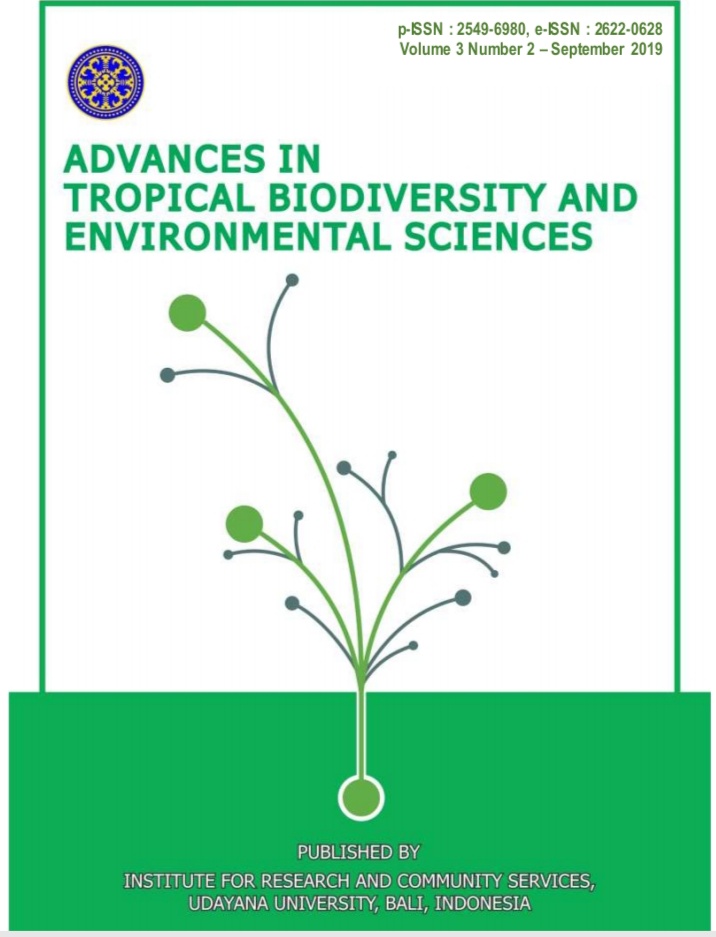Preliminary Phitochemical Analysis Of Guava Leaves (Psidium guajava L.) Extract As Antidiarrheal In Calves
Abstract
Guava plants (Psidium guajava L) are fruit plants originating from South America and can thrive in the territory of Indonesia. Now the biggest center for guava cultivation is spread in DKI Jakarta, West Java, Central Java, East Java, Yogyakarta, Bali, West Nusa Tenggara, Sumatra and Kalimantan. In addition to taking the fruit, guava leaves are also used as a traditional medicine for the treatment of diarrhea in human and animals. This study aims to identify active compounds in guava leaves. That is a secondary metabolites with pharmacological effects as anti diarrhea such as flavonoid, alkaloid, tannins and essential oils. The leaves sample used in this study were taken from farmers in the West Denpasar area, Bali. Extraction of guava leaf leaves using 96% ethanol, and phytochemical analysis was carried out to detect the presence of active compounds. The data obtained is presented and analyzed descriptively qualitatively. The results showed that the ethanol extract of guava leaves contained active compound inclaude steroid/triterpenoid, phenolics, alkaloids, flavonoids, saponins and tannins. It can be concluded that guava leaf extract contains are potential antidiarrheal
Downloads
References
[2] Mustofa, F.I., N. Rahmawati. 2018. Studi etnofarmakologi tumbuhan obat yang digunakan oleh penyehat tradisional untuk mengatasi diare di sulawesi selatan. Jurnal Tumbuhan Obat Indonesia, 11(2): 17-32.
[3] Nugraha, A.S., P.A. Keller. 2011. Revealing indigenous Indonesian traditional medicine: anti-infective agents. Natural Product Communications, 6 (12), 1953-1966.
[4] Barbalho, S.M., M.V. Flávia M. Farinazzi, D.A. Ricardo, A. Cláudia, S. Brunnati, A. Maria, B. Ottobon, C. Nicolau. 2012. Metabolic Profile of Offspring from Diabetic Wistar Rats Treated with Mentha piperita (Peppermint) Evid Based Complement. Alternat Med. pp 1-6.
[5] Trubus. 2013. 100 Plus Herbal Indonesia. Vol.11. Trubus, Depok. Issn 0216-7638.
[6] Sanda, K.A., H.A. Grema, Y.A. Geidam, Y.M. Bukar-Kolo. 2011. Pharmacological Aspects of Psidium guajava: An Update. International Journal of Pharmacology, 7: 316-324.
[7] Puspaningtyas, A.R. 2012. Evaluation of the effect of red guava (Psidium guajava) fruit extract on tyrosinase activity by pectrophotometry, International Current Pharmaceutical Journal, 1(5): 92-97.
[8] Agustina, E., F. Andiarna, N. Lusiana, R. Purnamasari, M.I. Hadi. 2018. Identifikasi senyawa aktif dari ekstrak daun jambu air (Syzygium aqueum) dengan perbandingan beberapa pelarut pada metode maserasi. Biotropic, 2(2): 108-118.
[9] Fratiwi, Y. 2015. The potential of guava leaf (Psidium guajava L.) for diarrhea. Journal Majority, 4(1): 113-118.
[10] Maysarah, H., R. Apriani, Misrahanum. 2016. Antibacterial activity test f ethanol extract of white and red flesh from guava leaf (Psidium guajava. L) againts Staphylococcus aureus and Escherichia coli. Jurnal Natural, 16(1): 51-56.
[11] Arifin, H., Agustina, Z. Rizal. 2013. Pengaruh pemberian jus jambu biji merah (Psidium guajava L.) terhadap jumlah sel eritrosit, hemoglobin, trombosit dan hematokrit pada mencit putih. Jurnal Sains dan Teknologi Farmasi, 18(1): 43-48.
[12] Biswas, B., K. Rogers, F. McLaughlin, D. Daniels, A. Yadav. 2013. Antimicrobial activities of leaf extracts of guava (Psidium guajava L.) on two gram-negative and gram-positive bacteria. Int J of Microbiology, Vol 2013 (746165): 1-7.
[13] Desiyana, L.S., M.A. Husni, S. Zhafira. 2016. Uji efektivitas sediaan gel fraksi etil asetat daun jambu biji (Psidium guajava linn) terhadap penyembuhan luka terbuka pada mencit (Mus musculus). Jurnal Natural, 16(2): 23-32.
[14] Prasetio, J.N. 2015. Potential red guava juice in patients with dengue hemorrhagic fever. Journal Majority, 4(2): 25-29.
[15] Cho, Y., K.J. Yoon. 2014. An overview of calf diarrhea - infectious etiology, diagnosis, and intervention. J. Vet. Sci. 15(1), 1-17.
[16] Rahayu, I.D. 2014. Identifikasi penyakit pada pedet perah pra-sapih di peternakan rakyat dan perusahaan peternakan. Jurnal Gamma, 9(2): 40-49.
[17] Muktar, Y., G. Mamo, B. Tesfaye, D. Belina. 2015. A review on major bacterial causes of calf diarrhea anf its diagnostic method. J. Vet. Med and Animal Health, 7(5): 173-185.
[18] Amelia, N., S.B. Prayitno. 2012. Pengaruh ekstrak daun jambu biji (Psidium guajava) untuk menginaktifkan Viral Nervous Necrosis (vnn) pada ikan kerapu bebek (Epinephelus fuscoguttatus). J Of Aquaculture Management & Tech, 1(1): 264-278.
[19] Wisesa, I.B.G.R., F.M. Siswanto, T.A. Putra, I.B.M. Oka, N.A. Suratma. 2015. Prevalence of Balantidium sp in bali cattle at different areas of bali. Int J of Agr, For. and Plant., Vol. 1 (Sept.): 49-53.
[20] Harborne, J.B. 1987. Metode Fitokimia Penuntun Cara Modern Menganalisis Tumbuhan. Penerbit ITB. Bandung.
[21] Marliana, S.D. and Saleh, C. 2011. Uji Fitokimia dan Aktivitas Antibakteri Ekstrak Kasar Etanol, Fraksi n-Heksana, Etil asetat, dan Metanol dari Buah Labu Air (Lagenari Siceraria). J. Kimia Mulawarman 8(2): 39-63.
[22] Haryati, N.A. and Erwin, C.S. 2015. Uji Toksisitas dan Aktivitas Antibakteri Ekstrak Daun Merah (Syzygium mytifolium Walp) terhadap Bakteri Staphylococus aureus dan Escherichia coli. J. Kimia Mulawarman. 13(1): 35-39.
[23] Umarudin, Susanti, R and Yuniastuti, A. 2012. Efektivitas ekstrak tannin seledri terhadap profil hiperkolesterolemi lipid tikus putih. Unnes Journal of Life Science 1(2): 78-85.
[24] Aripasha A., D. Andriana,Y. Purnomo. 2015. Efek dekok daun pulutan (Urena lobata) terhadap kadar SOD (Superoxyde dismutase) dan MDA (Malondialdehyde) serum tikus model diabetes mellitus tipe II. Jurnal Kedokteran Komunitas 3(1): 304-311.
[25] Hu. Y., Xu, J. and Hu, Q. 20013. Evaluation of antioxidant potential of Aloe vera (Aloe barbadensis Miller) extracts. J. Agriculture and Food Chemistry 51: 7788-7791.
[26] Sangi, M., Runtuwene, M.R.J., Simbala, H.E., and Makang, V.M.A. 2008. Analisis Fitokimia Tumbuhan Obat di Kabupaten Minahasa Utara. Chem. Prog. 1(1): 47-53.
[27] Akinpelu, B.A., O.A. Igbeneghu, A.I. Awotunde, E.O. Iwalewa, O.O. Oyedapo. 2014. Antioxidant and antibacretial activities of saponin fractions of Erythropheleum suaveolens (Guill and Perri) stem bark extract. Science Research Essays 18(9): 826-833.
[28] Malik, S., A.K. Verma, A. Kumar, M.K. Gupta, S.D. Sharma. 2012. Incidence of Calf Diarrhea In Cattle and Bufallow Calves in Uttar Pradesh, India. Asian Jornal of Animal and Veterinary Advadences. 7 (10): 1049-1054.
[29] Mailoa, M.N., M. Mahendradatta, A. Laga, N. Djide. 2016. Antimicrobial activities of tannins extract from guava leaves (Psidium guajava L) on pathogens microbial. Int. J. of Sci. & Tech. Res, 3(1): 236-241.
[30] Kenneth, E., T. Paul, N. Istifanus, U. Uba, A. Rejoice, O. Victor, S. Mohammed. 2017. Phytochemical analysis and antibacterial activity of Psidium guajava L. leaf extracts. GSC Bio and Pharm Sci, 01(02): 013–019.













